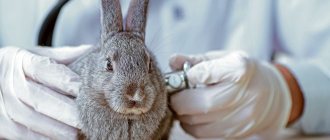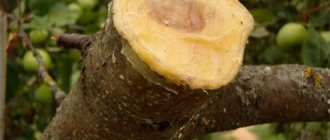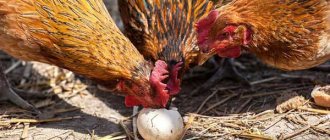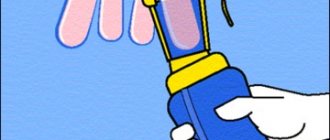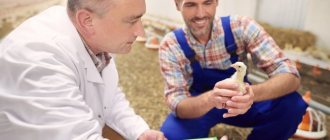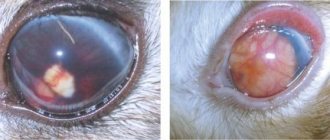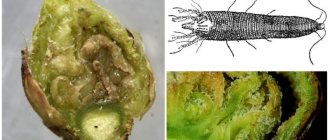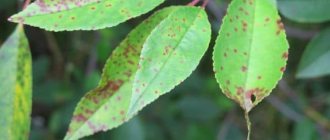August 18, 2017 Vladimir Khomyakov
Helminthiasis
HAVE YOU WONDERED HOW MANY worms live in our rabbits? It turns out quite a lot. And they are called differently depending on the status of the narrator. Among the people, these are simply worms; in scientific circles they use the term helminths, which, however, is translated from Greek (helminthos), as worms, and the essence of the matter does not change. Many inexperienced rabbit breeders do not even suspect that their animals are infected, because “cunning” creatures in the process of evolution have learned to camouflage themselves well. They sit inside their intestines or other organs and suck juices. They skillfully regulate their appetite so that the rabbit does not die, because then they too will have a hard time. But an experienced rabbit breeder will immediately notice that his ward is lagging behind in growth, does not reach the weight gain schedule, behaves strangely, and even looks somehow pale and skinny. And he is not at all happy with the fact that a significant part of expensive feed goes to fattening fat, disgusting and vile worms.
There is a third category of rabbit breeders who, having read about helminths, immediately runs to the pharmacy, buys medicine and begins general anthelmintic, and does this with such regularity that it does more harm than good. And how can we expect anything else, if any anthelmintic is a strong poison. I will say even more, one veterinarian I know even advises doubling the dose to be sure! Apparently to sell more. In addition to its direct effect, the drug kills the beneficial intestinal microflora, already undermined by the waste products of worms. In the case of deworming of a pregnant or lactating female, innocent rabbits receive severe poisoning and this puts their lives at risk. In general, this requires common sense, sober calculation and experience accumulated by rabbit breeders. Let's talk about this.
Later in the article I will dwell in more detail on several types of helminths (out of almost 12 thousand), which are the most dangerous and common among our rabbits. This, of course, does not mean that other types of these parasites are less dangerous. If cutaneous bloodsuckers and skin beetles have adapted to one type of animal and, for example, cat fleas do not “want to live” on rabbits, then worms in this regard know no boundaries and migrate practically between different animals. In the absolute majority, they do not take root completely, but for some time they wander through various parts and organs. I would especially like to point out that you and I are also in the risk zone here, and washing your hands again before eating would be a good thing. At your next medical examination, be sure to devote additional time to this issue.
Life cycle of helminths.
In general, strictly speaking, worms include not only the worms themselves - adult individuals, but also their larvae. They are the source of infection. First, they leave the body of a rabbit or other animal along with feces, disperse in the surrounding space, then, together with food, enter the body again, where new worms grow from them. Due to the fact that this dispersion can occur over a fairly large area, for example, with food, mice, birds and even insects, there is always a risk of infection for any rabbit. This is also facilitated by the fact that worm eggs can remain in “working condition” for a long time even in the open air, under the rays of the sun, and they are not afraid of frost. It’s also bad that a rabbit breeder cannot simply detect an infestation on the territory of his farm. Looking into an infected cell, he will not see anything there, since the eggs are microscopic in size. Some types of parasites generally undergo the initial phases of development in the bodies of insects, fleas, ticks, and lice and are transmitted when they are ingested.
But not all eggs, once in a rabbit’s body, turn into hated parasites. Most of them are simply destroyed by the acidic environment of the stomach or antibodies. An animal with a strong immune system, thanks to a proper diet, has stable acidity and is thus able to successfully resist infection. Even if some survive, they will be in such unfavorable conditions that the weather will not change. But we know that rabbits can become depressed at any moment. They might eat something spoiled or catch a cold, for example. There’s no need to tell you how easily rabbits get stressed. This is where, with the loss of immunity, the worms will recoup in full. It turns out to be a double blow to health, which not every rabbit can withstand. In terms of acidity, small rabbits who have just stopped drinking milk are completely unprotected. This is exactly what they have problems with. The final required acidic environment will be established in at least a month.
What's next? The eggs, as expected, mature, and small larvae hatch from them, which immediately begin to feed intensively. They don’t disdain anything. They adhere to blood and lymphatic vessels and pump blood, lymph, and other tissue juices into themselves. Half-decomposed food, instead of completing the full cycle of transformation and giving strength to the rabbit’s body, works for parasites. This is how adult and aging worms are replaced. Then nothing unusual happens in terms of development. Like any organism, the worm goes through a stage of youth, becomes sexually mature, periodically finds a partner, participates in procreation, grows old and dies. And all this time he eats, eats, eats.
DO NOT console yourself with the thought that by protecting the rabbit, carrying out thorough disinfection and regularly cleaning the cages, everything will fall into place. Of course, the problem would resolve itself after all the worms that had previously developed in the body grew old and died. But the life of a rabbit is short and it may not be enough for this. On average, intrauterine worms live from 3 months to 10 years, and some species can “celebrate” even a quarter of a century if a long-lived animal turns up. For example, a bear or a crow.
Real danger: harm to the body
Problems in the treatment of worms in rabbits are associated with the fact that helminths, when entering the body, are localized in various parts of the body. It happens that you treated animals for parasites in the intestines, but they hid in the bronchi. Worms can live in the liver, spleen, lungs or heart - destroying them every day.
While in the body of rabbits, parasites absorb blood, lymph and all sorts of useful substances supplied with food. Therefore, even with a good appetite, animals do not gain weight. Helminths destroy the mucous membrane of the gastrointestinal tract, disrupt metabolism and the functioning of the digestive systems.
If the parasites are not stopped in time, the animals will die. The cause of death may be a blockage of the intestine or rupture of its walls. Rabbits die from exhaustion or intoxication, as their body cannot cope with the toxins released by the worms. Even if the animals do not die, their immune system will suffer enormous damage, which will require a lot of time and money to restore.
How dangerous are worms?
The danger of parasitic worms is not only that they take food away from the rabbit, although even for this alone they should be subjected to persecution and obstruction. I won’t repeat myself too much, but loss of profitability and wasted money is putting it mildly. The slightest stress, an overdose of medicine, poor-quality water, slight malaise - and that’s it, your rabbit becomes vulnerable to worms and they begin to rule the roost. People are often perplexed that the rabbit was apparently healthy, but died suddenly. At autopsy there was nothing special: the liver, lungs, bladder and other organs were normal. And the feeding was normal, no suspicious or new ones were given out. Only the intestines are slightly inflated, it seems there is a lot of liquid in it. We conclude that most likely the cause should be sought in the proliferating worms. Take a close look to see if there are small white worms inside the intestines? Although you may not see them, as for example in the case of long roundworms, of which there are never many. Or they notice that the rabbit has stopped going to the toilet, is pouting, and is clearly suffering from pain, although he tries not to show it. Here, one of the reasons may be a complete blockage of the intestines with a plug of curled up worms. Yes, even the thought that worms constantly drink juices and blood from your pet should set you up to actively counteract them.
HELMINTHISIS is a parasitic disease caused by various types of parasitic worms. This is a very large group of diseases that have similar clinical symptoms and treatment approaches. The classification of helminth infections is based mainly on the type of worm parasite. According to the nature of the course, acute and chronic stages of the disease are distinguished. Separately, we can designate a latent form or an incubation period when infection has occurred, but manifestations have not yet been observed.
But there is also harm of indirect action. Surely you know that the weakest link in a rabbit’s body (statistics is a stubborn thing) is digestion. How are helminths related to it? The fact is that in the process of suction of the parasite, damage to the intestinal mucosa occurs. This in turn causes irritation, pain, and disruption of the food digestion process. Pathogenic microbes, previously harmless and powerless to harm, immediately rush into the resulting wounds. They especially often cause gastrointestinal diseases accompanied by diarrhea. Treating them is doubly difficult, because at the same time you need to drive out parasites and heal wounds. In addition, let's think about how many poisons are released by the “army” of intestinal inhabitants? And this happens all the time, day and night, without weekends or holidays. Not all poisons are eliminated from the body. A significant part of them is absorbed into the blood, spread throughout the body, to all vital organs, settling in them, disrupting the well-functioning mechanism of interaction through the nervous system. The rabbit becomes uncomfortable living, he withdraws, suffers and because of this he grows even more slowly. Many types of worms, before laying eggs, accumulate in the lower part of the rectum and even come out of the body, crawling around the anus, which causes severe itching. The rabbit constantly rubs against objects in the cage. In general - no life. Not all helminths affect the rabbit and develop in its body in the same way. I propose to consider the features of some of the most common ones.
Symptoms of helminthiasis
Parasites take over the victim’s body gradually, so it is not easy to recognize the danger in time. Alarming symptoms indicate that your eared pet is infected with helminths:
- The animal shows an insatiable appetite, but the animal’s weight is greatly reduced.
- The pet drinks water greedily every now and then.
- The animal sheds heavily. If left untreated, the number of parasites increases and shedding becomes more intense.
- The rabbit gradually develops diarrhea or, conversely, constipation. An admixture of greenery is visible in the excrement.
- The anal area becomes inflamed and takes on a reddish tint.
- In some cases, the pet refuses food, sits indifferently in the corner of the cage and does not respond to touch.
See also
Description and characteristics of rabbits of the Risen breed, their colors and contentsRead
General information about prevention.
It is much more profitable and easier to prevent infection with worms than to then drive them out. Fortunately, there are now enough funds for this. Considering the predisposition of young animals, I recommend giving them water for prevention, in case something bad has already started. The gentle suspension “Shustrik” is perfect. However, there is no need to rush. Conduct the event no earlier than 3 weeks of age. Plan in advance for drinking for expectant mothers, because after pregnancy it can no longer be done, and even during the breastfeeding period. The importance of the event is also that worms can migrate from the mother to the offspring.
AFTER worming, at least 2 weeks must pass before scheduled vaccination so that the rabbit’s body has time to recover. The same periods are valid for drinking coccidiostats. Please note that an organism infected and weakened by worms will not develop the required immunity and may even die. If you have other pets on your farm, deworm them at the same time and disinfect their habitats. Then the result will be as effective as possible.
Surely you have heard about homeopathic methods of combating worms. If you regularly use plants such as wormwood, tansy, and yarrow, the likelihood of infection is sharply reduced. They will certainly support the rabbit during the period between scheduled preventative care. I will specifically focus on pumpkin seeds. They contain the substance cucurbitin, which paralyzes intestinal worms and therefore they come out en masse in the feces and do not leave any traces. The thin layer between the grain and the peel is richest in this substance. Therefore, it is best not to peel the pumpkin seeds, but after drying them a little, grind them in a meat grinder and add them to the food. There is no point in frying them either.
Main types of parasitic worms.
To begin with, I propose to classify all the thousands and thousands of types of worms, sort them, as they say, into shelves. These shelves, even virtual ones, will not look very attractive, but what can you do for the good? So, the easiest way to divide parasites is by appearance. Rabbits are characterized by: cestodes - tapeworms with hooks for attaching to the intestinal walls, nematodes that have a round shape in diameter, trematodes or flatworms, snaggle-toothed worms - blood flukes. But this is a fairly general division. Let's make the situation even more specific and move on to individual, frequently encountered creatures. There is neither time nor desire for all of them, especially since their essence is close, as are the methods of expulsion.
How to treat rabbits with home remedies
The use of home remedies is justified by the fact that subsequently there will be no chemicals left in the meat that enter the human body.
| Raw materials | Mode of application |
| Sagebrush | The herb is active against pinworms and roundworms. It is fed to rabbits with the main diet in the amount of 30% of the total feed weight. Young rabbits are given a smaller amount. |
| Tansy | Tansy is popularly called glisten. It is given in the same way as wormwood - mixed with the main food. You can feed 2-3 branches separately. |
| Needles | Needles can be harvested only in severe frost, about 20 degrees, to avoid poisoning of animals. The raw materials are mixed into the feed. |
| Pumpkin | The seeds are fed to rabbits daily in small quantities. |
Passalurosis.
Looks like a dummy.
One of the manifestations of helminthiasis. This disease is caused by pinworms - small roundworms, typical of the nematode Passalurus . When they enter the body, they occupy the large intestine, colon and cecum. But when the time comes to lay eggs, they strive for the exit and accumulate at the anus. Initially, infection occurs precisely from the eggs present in the feed. Having passed through the aggressive environment of the stomach, the surviving embryos emerge from the shell, feed, and develop in the large intestine. Everything takes about 2 weeks or a little more. Then they are considered adults and can mate and lay new eggs themselves. There are many more of the latter, so the incubation period ends here, and the real disease sets in. By the way, in humans, pinworm infection is called differently, namely enterobiasis (from the Greek enteron - intestines). And the name passarulosis is applied only to rabbits and hares.
Diagnostics.
Visible to the naked eye.
You won't see eggs in the balls, as they are very small. Egg sizes range from 0.03 to 0.05 mm. The worms themselves also firmly adhere to the intestinal walls. Even a laxative cannot get rid of them. Only occasionally can a single individual be seen in the stool balls. Passarulosis can be determined by the characteristic actions of the rabbit. He, experiencing severe itching from parasites crawling along the mucous membrane of the anus and its outer part, rubs against all surfaces in the cell, that is, against the floor and walls. If you notice that the rabbit is in an unusual sitting position, it is worth wondering if it is suffering from pinworms. Turn your pet backwards, look at the anus, check for scratches or scratches. As a result of dysbacteriosis, diarrhea is often observed or greenish, sometimes white mucus appears on the balls. Increased thirst causes the rabbit to quickly empty the drinking bowls. An experienced rabbit breeder will notice signs characteristic of vitamin deficiency. Low activity, dull coat, and growth retardation should alert you. In a particularly active phase of the disease, rabbits not only do not gain weight, but even lose weight, although feeding is carried out at the proper level. The following video shows how you can visually verify the presence of worms. A massage of the rectum is performed so that soft and warm feces come out, from which the parasites do not have time to retreat, as during the usual discharge of needs.
Pay closer attention to young individuals, as their immunity is not so strong. Young people become infected faster than others. The most unfavorable period is from 3 to 6 months. Without preventive measures, up to 65% of animals can get sick. But the most accurate diagnosis regarding helminthiasis can be made by a doctor. Depending on his technical arsenal, he can determine the presence of pinworms by microscopy of smears, scrapings of the perianal folds (anus), by examination of stool, or even by a blood test for the presence of antibodies produced. In a dead rabbit, adult worms are clearly visible when the large intestine is opened.
AVOID harvesting grass in swampy areas. There is a high probability of the presence of helminth eggs in it. Be wary of meadows and fields where hares or wild rabbits appear en masse. They are most likely carriers of infection. It is much safer to use such grass for hay and use it no earlier than 6 months after drying. Do not forget about basic preventive measures. I mean regular cleaning of cages and equipment, periodic disinfection, and especially before the arrival of new additions.
Treatment
Treatment for passalurosis is well developed and quite effective. First, keep the rabbits on a starvation diet for about a day, then give piperazine sulfate in doses of one and a half grams per 1 kg of animal weight, mixing it with the feed. This is a one-time thing. Or a more gentle treatment for 12 days, when using Phenothiezin 0.1 All this time, you need to carefully clean the cells, and under no circumstances should the feces be taken out or buried, but only burned or, more precisely, subjected to heat treatment. Ivermec based on is widely used It is administered intramuscularly. Destroys not only helminths, but also all skin parasites. But this is a very strong poison, it is used in extreme cases. If you contact a veterinary pharmacy, they may also offer you other drugs, for example, Ivomec, Albendazole, Mebendazole, Fenbendazole (Panacur), Febantel. Personally, I use two drugs: Shustrik and Albendazole . The first is a gentle type, great for children, although it is also suitable for adults. The second is much stronger, and therefore more poisonous. It should be used in case of severe mass infections. But that is not all. After deworming, it is necessary to restore beneficial microflora and support the immune system well. In the first case, use probiotics, for example Vetom 1.1 , in the second, the immunomodulator Gamavit .
Echinococcosis. In everyday life - rabbit cysticercosis.
Cysts in the form of clusters of eggs in echinococcosis.
Echinococcosis or cysticercosis in rabbits does not quite fit into the generally accepted idea of worms. After slaughtering the animal, you will not find any worms in the body, as, for example, in the previous case. The thing is that eared animals are only an intermediate link in the overall development scheme of this parasite. To make everything immediately clear, let's describe the entire life cycle of echinococcus. For its complete completion, two animals are required. On our farms it is a rabbit and a dog or cat. And in the wild, a hare can play the role of a rabbit, and a wolf, jackal, or fox can play the role of a dog or cat. Due to a misunderstanding, echinococcosis is often called rabbit cysticercosis. This is fundamentally wrong. Echinococcus granulosis and Cysticercus cellulosae are different Finns and cannot change hosts. Everyone becomes attached to certain animals or people.
THERE ARE other types of parasitic tapeworms that involve other animal species and even humans. For example, a pork tapeworm (tapeworm) part of its life is in the pig’s body in the phase of encapsulated finn, and part of it is in the human body in the form of a tapeworm. The disease caused by such a parasite is called cysticercosis.
So, the carriers of adult tapeworms are mainly dogs. The parasites, it must be said, are not very large, only 2.5-8 mm long. The scolex or head, located in the head section of the parasite, has 4 suckers and a double crown of 35-40 hooks with which it clings to the intestinal wall. Such a parasite, in order to continue its kind, produces hundreds and hundreds of eggs, which are released with detached shadow segments along with dog feces. These segments can move independently and distribute eggs over a large area, infecting the territory. In the wild, for example, meadow grass can be infected; in households, the territory becomes infected and the eggs are spread from it by the wind, birds, rodents and end up on food and drinking water.
| Subscribe to our website's weekly newsletters: Current notes on keeping rabbits are waiting for you. SUBSCRIBE |
The danger of eggs (infestation) persists for a very long time, up to 18 months. Thus, the path into the rabbits’ body becomes open. Next, the shell of the eggs dissolves in the stomach, and the oncospheres that are on the warpath skillfully work with their hooks and make their way into the capillaries. Then their path lies to the liver. This first intermediate collection point is the first to suffer from aggression. If you kill such a rabbit, you will see that the liver is heavily damaged by cysts, all riddled with white cords. These passages have already been eaten and are filled with connective tissue. And this is just the beginning. We know that the main function of the liver is to cleanse the blood, which means that the path from it goes to absolutely all parts of the body (heart, lungs, brain). There, most of the parasites die, but the rest complete their larval development. The majority remains in the liver. In 3-4 weeks, as they grow, they reach the surface of the organ, pierce the capsule and move into the abdominal cavity.
ECHINOCOCCA larvae have the shape of a vesicle (larvocyst), filled with a clear liquid, the size of a pea, with a scolex retracted inside, the same structure as the scolex in mature individuals. Daughter and grandchild bladders can form inside the mother's bladder. Larvocysts have two membranes: the outer cuticular and the inner germinal. In addition, on the surface, each vesicle is covered with a connective tissue membrane formed by the host tissues. Larvocysts are localized under the serous membranes of the abdominal cavity, less often in the chest cavity, in the brain and other organs.
You can often find vesicles - larvocysts in the following places: the middle, the lung, under the pleura of the diaphragm, under the liver capsule, the space between the liver and the right kidney, the pancreas, in the abdominal cavity, near the final segment of the rectum. But the greatest probability of detection is on the peritoneum. It has several folds or bags. One of them houses the large omentum, where the bulk of the parasitic vesicles find refuge.
Preventive actions.
From all that has been said, it is not difficult to draw conclusions and assess the risks of echinococcosis in rabbits. The most likely source of infection is a dog. Whether it's yours or a stray one doesn't matter. They are the ones who can eat the meat or entrails of a rabbit that contained tapeworm larvae. Then it’s a simple matter: after 65 days, the larvae will develop into small tapeworms, carriers of new eggs. We cannot exclude the possibility that you bought already infected rabbits. If the seller has dogs on the farm, then the risk of this increases sharply. Yes, and cats can taste contaminated meat and cause all the troubles. And wild animals. For example, our area is full of foxes that are practically not afraid of people and visit farms as if they were their own property. To dramatically reduce the likelihood of spreading echinococcosis, never feed dogs or cats raw rabbit meat and intestines, and do not throw them in the trash. And during each gutting and livering, carefully inspect the carcass for the presence of harmful bubbles - beads or even cysts. Remove and dispose of carcasses of dead animals immediately. If you exclude the possibility of dogs and cats eating contaminated meat and feed them with proven food, then echinococcosis will not spread to the entire household. In other words, it does not spread directly between rabbits, except by infecting the fetuses of a pregnant female. And of course, don’t forget about scheduled deworming. Experienced rabbit breeders conduct them 2 times a year, at the beginning of spring and at the beginning of autumn (hay-grass transition and vice versa). If there is an increased risk of echinococcosis, I recommend that all livestock be given 10% mebenvet granules in the feed during morning feeding for 5 days. The dosage is indicated in the instructions.
DO NOT keep dogs on large rabbit farms and especially near slaughtering stations and feed warehouses. You should only get by with guard dogs on a leash. They must be periodically checked, at least 4 times a year, and prevented with special medications. Stray dogs, cats, and foxes should be combated on farms and surrounding areas.
Danger to humans.
Echinococcosis of rabbits and hares is not dangerous to humans. They even write that the meat of an infected rabbit after heat treatment is allowed to be consumed, and the entrails can be disposed of after heat treatment. However, I would still not advise risking your health. Still, the carcass is contaminated with toxins and it is not a fact that their concentration will become safe after boiling or frying. And who knows how the tapeworm embryo will behave in the human body until it is destroyed by the immune system? After all, there is always a possibility that it hid somewhere in the carcass and survived after the dish was prepared. Personally, I have not performed such experiments on myself; I have not read conclusions in scientific publications that can be completely trusted.
How to determine echinococcosis?
It is problematic to do this in live rabbits, since the clinical picture and symptoms are not always clearly expressed. Often, after slaughtering a rabbit that seems to him to be absolutely healthy, a rabbit breeder often discovers an affected liver (sometimes it looks healthy) and beads made of round transparent watery balls attached to one or another organ. Only with a severe degree of infection, when the rabbit has swallowed a lot of eggs, weakness, lethargy and depression are noticeable against the background of developing diarrhea. He will sit with a detached look, refuse to feed and lose weight. The animals become so lethargic that when you try to pick them up, they don’t resist at all. Yellowness and dullness appear on the mucous tissues. This is a consequence of liver inflammation and peritonitis. When massaging the abdomen in the liver area, one feels uneasy due to pain. If a rabbit has reduced immunity, echinococcosis can completely finish off the unfortunate animal. As in the first case, the most vulnerable are young animals. The age from 1 to 3 months is the most unfavorable. If, on the contrary, the body’s resistance is normal, the rabbit’s appetite is gradually restored, hepatitis and inflammation of the peritoneum subside, and healing occurs. But this does not mean that echinococci have disappeared somewhere. No, they can live inside a rabbit for years, waiting until the dog swallows them.
Treatment of echinococcosis.
Treatment must be approached comprehensively. Before feeding animals, analyze what is the cause of the infection. Perhaps it lies in low-quality, stale food, old water in the tank, perhaps in sick dogs and cats? Then something needs to be done about this, otherwise everything will happen again and again. As for rabbits, there are a lot of drugs, both traditional and new. For example, back in Soviet times, anthelmintic drugs were used: Mebendazole 5 ml/kg every day for 5 days, Fenbendazole-10 mg/kg once, Thiabendazole-75 mg/kg for 3 days. Praziquantel (10 mg/kg) is specifically designed to combat tapeworms, but it is also included in the above-mentioned Shustrik. Kills both eggs and larvae. Today I specifically ran into the veterinary pharmacy and asked what new products had appeared. I was advised to use Dirofen paste for rodents with pumpkin oil. The annotation says that it is effective against nematodes and cestodes; a starvation diet is not needed. Anyone who has used it, please respond.
Is infection possible?
Unfortunately, the presence of helminths in the body of seemingly herbivorous animals is a fairly common phenomenon. After all, they are prone to eating food that is a source of infection:
- This, for example, can be various root vegetables , which caring owners regularly feed to their pets. Often, particles of soil remain on these vegetables, which may contain a large number of helminth eggs.
- Another common cause of infection in rabbits is their eating grass that has been contaminated with feces of previously infected animals (most often dogs). In this case, the likelihood of helminth eggs entering the body is also high.
Let's summarize and highlight the most important points.
- The issue with worms cannot be left to chance, otherwise they will cause a lot of trouble. It is not possible to completely isolate yourself from parasitic worms.
- Constantly monitor the degree of infection of animals with helminths by external manifestations, or better yet by analysis. Not only rabbits, but also other animals on your farm.
- Carry out preventive measures to maintain the cleanliness of cages and other places where animals are kept and equipment. Fight against rodents and fleas.
- Procure feed from trusted sources, do not feed old, stale feed. Do not mow grass in swampy areas or meadows where hares have been spotted.
- Do not keep dogs in rabbit farms, do not allow their wild relatives, cats, and foxes to appear. Keep watchdogs on a chain and worm them regularly.
- Buy new rabbits from reputable breeders. Make sure they don't have dogs living near their cages. Place brought pets in quarantine, or better yet, worm them immediately.
- Before mating and routine vaccinations, including young animals, check rabbits especially carefully for worms or use the drug “Shustrik” to guarantee. The vaccine should be injected no earlier than 2 weeks after deworming.
- Decorative rabbits must be prevented by applying special sprays to the withers at least once every three months. Rabbits on farms can also be prevented with the same regularity. At the same time, worm all animals living with you.
- In each specific case, analyze the possibility of measures taking into account the timing of matings and slaughter. Traces of poisons may remain in the meat. Use extreme caution when handling infected rabbits, as some types of worms are dangerous to humans. During routine medical examinations, but at least once a year, be checked by an infectious disease specialist.
Please share this article with your friends on social networks:
Please rate the article. Ask a question, discuss on the forum.
Traditional methods
Effective and completely free methods of treatment include the use of herbs by animals such as tansy or wormwood. And in winter, they can be perfectly replaced by pine needles. Rabbits will also enjoy eating it. Prevention also includes consuming these plants from time to time.
Sagebrush
This is an excellent anthelmintic that even Alben can compare with. Their treatment is very effective. And in cases where a rabbit eats wormwood along with plant food, its appetite noticeably improves. The grass helps both animals and people against worms equally well. In order for this remedy to give quick results, wormwood is added to the fragrant hay, which makes up at least 30% of the daily plant food for animals.
Tansy
Tansy is not only very useful as a medicine, but can also decorate a site in the summer, because it is a beautiful plant in itself. In order to get rid of worms, tansy is given to rabbits in the same daily amount as wormwood.
Needles
The needles of spruce trees are indispensable in the fight against helminths when it was not possible to prepare tansy and wormwood for the winter. The only condition: the collection of needles must be carried out at a temperature of −20C and below. This is explained by the fact that too many essential oils are concentrated in needles collected in warm weather. Their excess can harm the health of the eared one.
You can combine herbs and pine needles, giving them to the fluffies for several days in a row. It is imperative to ensure that animals always have clean and fresh water.
